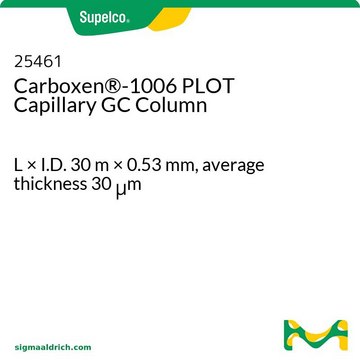25467
Carboxen®-1010 PLOT Capillary GC Column
L × I.D. 30 m × 0.53 mm, average thickness 30 μm
Synonym(s):
Carboxen® 1010 PLOT Column, 30m x 0.53mm
About This Item
Recommended Products
material
fused silica
Agency
ASTM® D3612-96
description
PLOT = Porous Layer Open Tubular
manufacturer/tradename
Carboxen®
parameter
≤25-250 °C temperature (isothermal or programmed)
average thickness
30 μm
df
30 μm
technique(s)
gas chromatography (GC): suitable
L × I.D.
30 m × 0.53 mm
matrix active group
Carbon molecular sieve phase
application(s)
chemicals and industrial polymers
food and beverages
column type
capillary PLOT
Looking for similar products? Visit Product Comparison Guide
General description
USP Code: None
Phase:
- Carbon molecular sieve
- Subambient to 250 °C (isothermal or programmed)
Other Notes
Legal Information
Choose from one of the most recent versions:
Already Own This Product?
Find documentation for the products that you have recently purchased in the Document Library.
Customers Also Viewed
Protocols
GC Analysis of Nitrogen and Nitrous Oxide on Carboxen®-1010 PLOT
Separation of null
Separation of null
Chromatograms
suitable for GCOur team of scientists has experience in all areas of research including Life Science, Material Science, Chemical Synthesis, Chromatography, Analytical and many others.
Contact Technical Service








